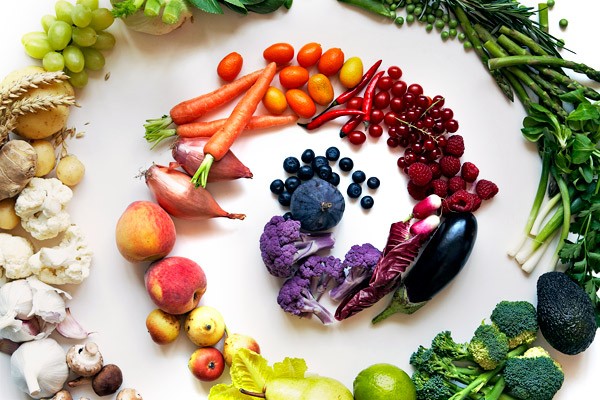Alrighty, it’s time to give you the low-down on vegetables! I’m sure you have all heard it before ‘eat 5 servings every day’. That is a good start, but do you know that most people only consume half the recommended amount … are you one of them?
HOW MUCH IS A SERVE?
1 serve = 1 cup of green leafy or raw salad vegetables OR ½ cup cooked vegetables.
WHY VEGGIES ARE IMPORTANT
Eating 5-7 serves of vegetables daily will nourish the body with the nutrients, antioxidants and phyto-chemicals it requires to repair and function optimally. A recent study found that individuals who consumed 7 or more servings of vegetables per day had a decreased risk of developing cancer and cardiovascular disease. Don’t be put of by the numbers, of course there will be some days you won’t reach the target but if you can aim for it as often as possible then that’s a good start!
If chronic health conditions are a major concern for you now, can I remind you that eating vegetables reduce the aging process, gives you radiant skin, clear eyes, supports digestion (reduced bloating), boosts immunity & energy!
How to Increase Your vegetable Intake
1. START WITH BREAKFAST
Breakfast is a great way to knock-off a few of your daily serves. Cook up two eggs and serve it with 1 – 2 serves of veggies, my favourites are spinach, tomato, mushrooms, onion, avocado and kale. Or whip up a green smoothie as discussed further down.
2. MAKE IT YOUR MAIN
The typical Western diet consists of meat and grains as the main portion of a meal, if they have a side of veggies then that’s a bonus. Try serving vegetables as the main portion of your plate – stir-fry, steam, wilt, roast them…whatever you like, just don’t laden them with cheese or butter ![]() Then add a palm sized serve of protein, and some wholegrains on the side – either brown rice, quinoa, buckwheat or millet (I don’t follow a strict Paleo diet, there’s no one diet for everyone). This way you should have at least 2 – 3 servings of vegetables done and dusted in one meal!
Then add a palm sized serve of protein, and some wholegrains on the side – either brown rice, quinoa, buckwheat or millet (I don’t follow a strict Paleo diet, there’s no one diet for everyone). This way you should have at least 2 – 3 servings of vegetables done and dusted in one meal!
3. 4 SEASON’S OF SALAD
You don’t need to wait until summer to enjoy delicious salads. Be creative, and make beautiful warming salads throughout the winter. I do suggest eating raw, cooling salads during the summer – it’s better for digestion, and lightly cooked/heated salads during winter. Roasted beetroot, sweet potato, sautéed cherry tomatoes are all great options, toss them in with some greens or grated carrot and cabbage and you will have a warming winter salad.
4. SOUP-ER GOOD!
One of my favourite things about winter is that it’s soup season! Soup is a really easy way to get a variety of veg. Add in some good quality bone broth or stock (preferable home-made) to heal your gut, a bunch of herbs and spices and you have the perfect nutritious meal to support digestion and boost your antioxidant intake. I like to make a big batch up every Sunday to last me the week, it also makes a great snack option to keep your energy levels up in the afternoon!
5. SNEAK’EM IN YOUR SMOOTHIE
Smoothies are a great way to sneak in some veg. If you’re just starting out try adding a handful of spinach to a blueberry or banana smoothie. One thing I strongly urge is to ROTATE YOUR GREENS. Raw spinach, kale and other salad greens contain ‘oxalates’. These constituents will bind to minerals in the body and excrete them – leaving you depleted. That’s why I recommend mixing up your green options, so you get a good variety. Small amounts are fine in moderation, please be cautious of this especially if you’re iron deficient. Spirulina, wheatgrass and chlorella are other excellent green options!
6. SNACK ON IT
Veggie sticks and hommus are healthy snack options to have during the day. I like cucumber, carrot, capsicum, zucchini and celery – don’t forget to rotate them throughout the week. If you’re not one to prepare veggie sticks on a regular basis, spend 15 minutes on a Sunday cutting them up so they are ready to go.
7. SWAP IT
Potato chips – they really aren’t all that! Whilst they might taste good, and fill that emotional void temporarily, they don’t provide nutrient value AT ALL. Plus many of them are deep fried in oil. Swap potato for sweet potato – it is higher in nutrients and is low in GI. Kale chips are another great option, especially when they are seasoned with spices…mmmm!
8. JUICE IT
Veggie juices are great when made in the right portions. I recommend 1 piece of fruit to sweeten things up a little, but you mainly want the base to be all vegetables. Juices are easier to digest and absorb nutrients, I don’t suggest replacing all your veggie servings with juice because you won’t get the fibre content, however 1 a day is highly beneficial.
9. BAKE IT
If you’re into baking beautiful fresh healthy cakes (like myself!) it’s very easy to disguise vegetables in them – the kids won’t even know! Grate a zucchini into chocolate cake, or try sweet potato brownies, or a healthy version of carrot cake. While it may not make your 5 servings in one piece, it’s a healthy little addition instead of the sugar-laden cakes in the shops.
10. TOP IT OFF
Lucky last, add some green’s to season your meal. A generous handful of parsley, basil or coriander are still green leafy’s! It’s a simple way to add flavour, plus herbs are insanely high in antioxidants – another bonus!
I hope this has inspired you to add a few more veggies into your daily routine! If you have any other tips that you do I’d love to hear them!

